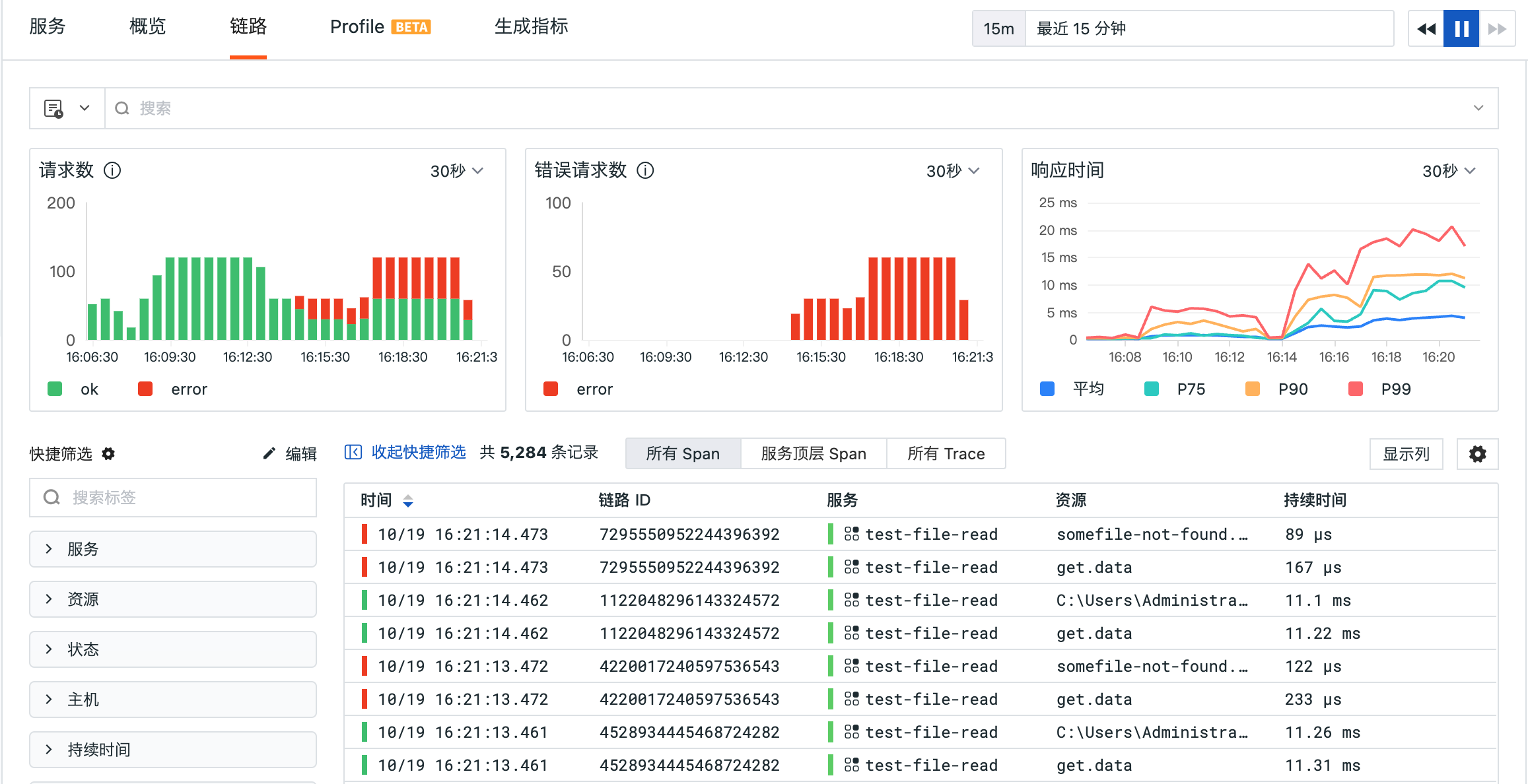DDTrace Golang
There are two ways to instrument your Go application:
1. Compile-time Instrumentation¶
- Ensures maximum coverage of your tracing instrumentation.
- Does not require source code modifications, making it ideal for integrating at the CI/CD level.
- Install DataKit and config DDTrace
2. Manual Instrumentation¶
Use dd-trace-go in conjunction with our integration packages to automatically generate spans for libraries of your choosing. This option:
- Gives you complete control over which parts of your application are traced.
- Requires modifying the application’s source code.
Requirements¶
- Applications must be managed using Go modules. Module vendoring is supported.
- Go Tracer requires Go 1.18+.
Install Orchestrion¶
If the installation fails, try cloning the project locally and compiling it again.
git clone https://github.com/DataDog/orchestrion.git
cd orchestrion/
go build
cp orchestrion $GOPATH/bin/
Register Orchestrion in your project’s go.mod:
# commit changelog
git add go.mod go.sum orchestrion.tool.go
git commit -m "chore: enable orchestrion"
Usage¶
Use one of these methods to enable Orchestrion in your build process:
1 Prepend orchestrion to your usual go commands:
2 Add the -toolexec="orchestrion toolexec" argument to your go commands:
go build -toolexec="orchestrion toolexec" .
go run -toolexec="orchestrion toolexec" .
go test -toolexec="orchestrion toolexec" ./...
3 Modify the $GOFLAGS environment variable to inject Orchestrion, and use go commands normally:
# Make sure to include the quotes as shown below, as these are required for
# the Go toolchain to parse GOFLAGS properly!
export GOFLAGS="${GOFLAGS} '-toolexec=orchestrion toolexec'"
go build .
go run .
go test ./...
More Documentation¶
Manual instrumentation¶
Install the DDTrace Golang SDK:
Install the profiling library
Other libraries related to components, as needed, for example:
go get gopkg.in/DataDog/dd-trace-go.v1/contrib/gorilla/mux
go get gopkg.in/DataDog/dd-trace-go.v1/contrib/net/http
go get gopkg.in/DataDog/dd-trace-go.v1/contrib/database/sql
We can learn more about available tracing SDKs from the Github plugin library or Datadog's related support documentation.
Code Examples¶
Simple HTTP Server¶
package main
import (
"log"
"net/http"
"time"
httptrace "gopkg.in/DataDog/dd-trace-go.v1/contrib/net/http"
"gopkg.in/DataDog/dd-trace-go.v1/ddtrace/tracer"
"gopkg.in/DataDog/dd-trace-go.v1/profiler"
)
func main() {
tracer.Start(
tracer.WithService("test"),
tracer.WithEnv("test"),
)
defer tracer.Stop()
err := profiler.Start(
profiler.WithService("test"),
profiler.WithEnv("test"),
profiler.WithProfileTypes(
profiler.CPUProfile,
profiler.HeapProfile,
// The profiles below are disabled by
// default to keep overhead low, but
// can be enabled as needed.
// profiler.BlockProfile,
// profiler.MutexProfile,
// profiler.GoroutineProfile,
),
)
if err != nil {
log.Fatal(err)
}
defer profiler.Stop()
// Create a traced mux router
mux := httptrace.NewServeMux()
// Continue using the router as you normally would.
mux.HandleFunc("/", func(w http.ResponseWriter, r *http.Request) {
time.Sleep(time.Second)
w.Write([]byte("Hello World!"))
})
if err := http.ListenAndServe(":18080", mux); err != nil {
log.Fatal(err)
}
}
Compile and run
Manual Tracing¶
The following code demonstrates trace data collection for a file opening operation.
In the main() entry code, set the basic trace parameters and start tracing:
package main
import (
"io/ioutil"
"os"
"time"
"gopkg.in/DataDog/dd-trace-go.v1/ddtrace/ext"
"gopkg.in/DataDog/dd-trace-go.v1/ddtrace/tracer"
)
func main() {
tracer.Start(
tracer.WithEnv("prod"),
tracer.WithService("test-file-read"),
tracer.WithServiceVersion("1.2.3"),
tracer.WithGlobalTag("project", "add-ddtrace-in-golang-project"),
)
// end of app exit, make sure tracer stopped
defer tracer.Stop()
tick := time.NewTicker(time.Second)
defer tick.Stop()
// your-app-main-entry...
for {
runApp()
runAppWithError()
select {
case <-tick.C:
}
}
}
func runApp() {
var err error
// Start a root span.
span := tracer.StartSpan("get.data")
defer span.Finish(tracer.WithError(err))
// Create a child of it, computing the time needed to read a file.
child := tracer.StartSpan("read.file", tracer.ChildOf(span.Context()))
child.SetTag(ext.ResourceName, os.Args[0])
// Perform an operation.
var bts []byte
bts, err = ioutil.ReadFile(os.Args[0])
span.SetTag("file_len", len(bts))
child.Finish(tracer.WithError(err))
}
func runAppWithError() {
var err error
// Start a root span.
span := tracer.StartSpan("get.data")
// Create a child of it, computing the time needed to read a file.
child := tracer.StartSpan("read.file", tracer.ChildOf(span.Context()))
child.SetTag(ext.ResourceName, "somefile-not-found.go")
defer func() {
child.Finish(tracer.WithError(err))
span.Finish(tracer.WithError(err))
}()
// Perform an error operation.
if _, err = ioutil.ReadFile("somefile-not-found.go"); err != nil {
// error handle
}
}
Compile and run
After running the program for a while, you can see trace data similar to the following in Guance:
Supported Environment Variables¶
The following environment variables are supported to specify some configuration parameters of DDTrace when starting the program, and their basic form is:
For more environment variable support, see DDTrace-Go Documentation.
Attention
These environment variables will be overridden by the corresponding fields injected with WithXXX() in the code, so the configuration injected by the code has a higher priority. These ENVs only take effect when the corresponding fields are not specified in the code.
-
DD_VERSIONSets the application version, such as
1.2.3,2022.02.13 -
DD_SERVICESets the application service name
-
DD_ENVSets the current environment of the application, such as
prod,pre-prod, etc. -
DD_AGENT_HOSTDefault:
localhostSets the IP address of DataKit, and the trace data generated by the application will be sent to DataKit
-
DD_TRACE_AGENT_PORTSets the DataKit trace data receiving port. Here you need to manually specify the DataKit HTTP port (usually 9529)
-
DD_DOGSTATSD_PORTDefault value:
8125If you want to receive StatsD data generated by DDTrace, you need to manually enable the StatsD collector on DataKit -
DD_TRACE_SAMPLING_RULESDefault:
nilHere a JSON array is used to represent the sampling settings (sampling rate application is in array order), where
sample_rateis the sampling rate, and the value range is[0.0, 1.0].Example 1: Set the global sampling rate to 20%:
DD_TRACE_SAMPLING_RULES='[{"sample_rate": 0.2}]' ./my-appExample 2: Service name wildcard
app1.*, and the span name isabc, set the sampling rate to 10%, otherwise, set the sampling rate to 20%:DD_TRACE_SAMPLING_RULES='[{"service": "app1.*", "name": "b", "sample_rate": 0.1}, {"sample_rate": 0.2}]' ./my-app -
DD_TRACE_SAMPLE_RATEDefault:
nilEnable the above sampling rate switch
-
DD_TRACE_RATE_LIMITSets the number of span samples per second for each Golang process. If
DD_TRACE_SAMPLE_RATEis already turned on, the default is 100 -
DD_TAGSDefault:
[]Here you can inject a set of global tags, which will appear in each span and profile data. Multiple tags can be separated by spaces and commas, such as
layer:api,team:intake,layer:api team:intake -
DD_TRACE_STARTUP_LOGSDefault:
trueEnable DDTrace-related configuration and diagnostic logs
-
DD_TRACE_DEBUGDefault:
falseEnable DDTrace-related debug logs
-
DD_TRACE_ENABLEDDefault:
trueEnable trace switch. If this switch is manually turned off, no trace data will be generated
-
DD_SERVICE_MAPPINGDefault:
nullDynamically rename service names, service name mappings can be separated by spaces and commas, such asmysql:mysql-service-name,postgres:postgres-service-name,mysql:mysql-service-name postgres:postgres-service-name
